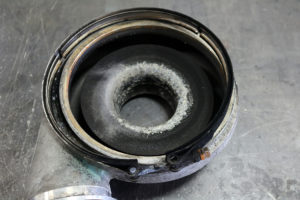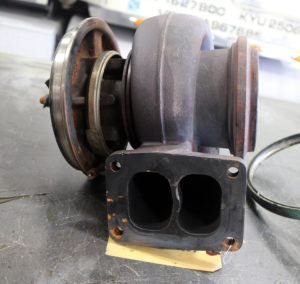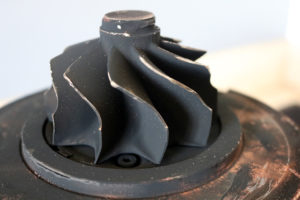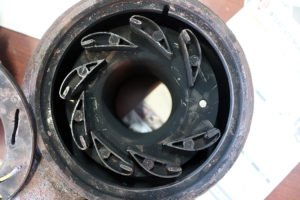Burned turbochargers are a good reason to have a working pyrometer, with the thermocouple in the exhaust manifold, and a turbo boost gauge. It’s also very important that you know what the readings mean. On April 28th, I returned a phone call to a gentleman that had sent us a turbocharger off of a 12.7 DD4 Detroit looking for a warranty. The failure was a burned turbine housing and .025 end play on the wheel and shaft, when there should be no more than .012 end play.
My first question to the owner was, “Do you have a pyrometer (EGT) gauge?” He replied, “No, but my truck doesn’t run hot.” I then asked, “How do you know? It is impossible to know the exhaust gas temperature on these older engines without a pyrometer.” He did say the engine produced 25 to 27 psi of boost, which should be 30 psi for a 500 Detroit 12.7 liter, but at least he had a turbo boost gauge!
Now, here is where the problem lies – the rear gears in this truck were 2.91, turning 24.5 tall rubber, and the truck was equipped with a double over 13-speed transmission. He drives this truck, a 2003 Freightliner Columbia with a single air filter under the hood, at 70 mph at 1,200 rpm. The DD3 and 4 12.7-liter Detroits need to be run at 1,400 rpm and higher, especially at 70 miles per hour. Running this low rpm will produce excessive exhaust gas temperature, which is what fried the center section of the turbine housing.
This truck also had an air filter restriction which caused the thrust washer to wear out, giving the wheel and shaft .025 end play. With that much end play, the compressor wheel, on the fresh air side, had hit the compressor housing. The air filter could be dirty or could have gotten wet from driving through a downpour. If the air filter is paper and gets wet, it must be replaced very soon. A wet air filter will cause excessive wear on the thrust washer and pull oil past the seal and into the charge air cooler.
As you can see in the pictures, the turbine housing has been burned from excessive heat and end play. There is no warranty on this turbo, but I can save it by installing a bearing and seal kit, along with a new or used turbine housing. Excessive soot and carbon cause the variable vanes in a VGT turbo to lock up, rendering it useless.
In other photos here, a turbocharger off of an International 530 engine is pictured. The rust on the outside of this turbo shows that the truck sat in the grass for an extended period of time. Soil and grass hold moisture and will cause excessive rust. If the truck owner had been running our Max Mileage Fuel Borne Catalyst in his fuel, the truck would still be up and running. Now, he needs to spend $2,900 on a new turbocharger. As we say, it costs 1 cent per mile to run the catalyst, but it will save 6 cents per mile in maintenance.
We work on all sorts of engine components at our shop here in Saxonburg, PA – not just turbochargers. Stop by and visit us today or check us out online (www.pittsburgpower.com) 24/7 to see all our products and services. We are here to serve owner operators looking for more performance and efficiency out of their diesel truck. Call us at (724) 360-4080 to learn more about what we do and why.




